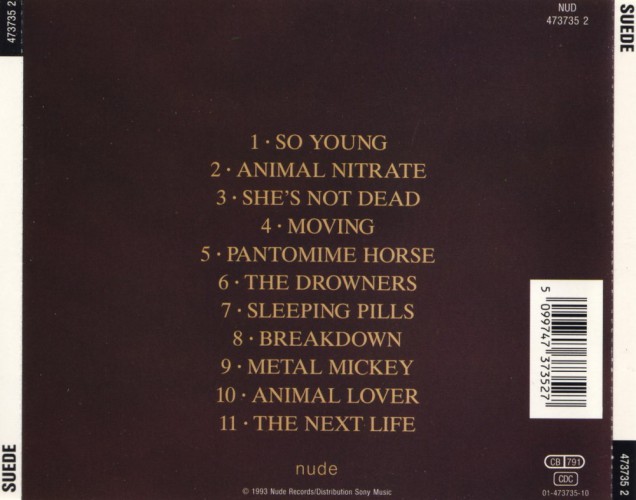Track List
01) So Young

02) Animal Nitrate

03) She's Not Dead
04) Moving
05) Pantomime Horse
06) The Drowners

07) Sleeping Pills
08) Breakdown
09) Metal Mickey

10) Animal Lover
11) The Next Life
12) He's Dead (Rocking Horse demo)
13) Where the Pigs Don't Fly
01) So Young
02) Animal Nitrate
03) She's Not Dead
04) Moving
05) Pantomime Horse
06) The Drowners
07) Sleeping Pills
08) Breakdown
09) Metal Mickey
10) Animal Lover
11) The Next Life
12) He's Dead (Rocking Horse demo)
13) Where the Pigs Don't Fly
3:38
3:27
4:33
2:50
5:49
4:10
3:50
6:02
3:27
4:17
3:32
4:11
5:36
Data Complete 80%
Total Rating
Total Rating
![]() (2 users)
(2 users)
Back Cover
CD Art
3D Case
3D Thumb
3D Flat
3D Face
3D Spine
First Released
![]() 1993
1993
![]() Alternative Rock
Alternative Rock
![]() Dreamy
Dreamy
![]() Britpop
Britpop
![]() ---
---
![]() Medium
Medium
![]() Album
Album
![]() 340,000 copies
340,000 copies
Album Description
Available in:

Suede es el álbum debut de la banda, llegó el 29 de marzo de 1993, publicado por Nude Records y distribuido por Sony.
La producción corrió a cargo de Ed Buller, productor que se convertiría en una figura clave en el sonido inicial del grupo. El disco se grabó en Master Rock Studios y Olympic Studios de Londres, en un ambiente de alta tensión creativa, Brett Anderson y Bernard Butler competían por ver quién aportaba más dramatismo, mientras Mat Osman y Simon Gilbert trataban de mantener el pulso rítmico.
El sonido del álbum es una mezcla explosiva de guitarras ásperas y melódicas con un lirismo cargado de ambigüedad sexual y decadencia urbana. Anderson canta con un estilo andrógino que recordaba a Bowie y Morrissey, pero con un dramatismo aún más exagerado, mientras Butler desplegaba riffs que iban desde la furia hasta la delicadeza atmosférica. El disco fue percibido como un antídoto contra el grunge estadounidense, devolviendo a la música británica el sentido de glamour y oscuridad teatral.
Las canciones destacadas forman ya parte del canon noventero: “Animal Nitrate”, con su riff en espiral y su provocación lírica sobre deseo y drogas; “So Young”, que abría el álbum con un estallido de juventud eufórica y nihilista; “Metal Mickey”, donde Anderson se lanza al histrionismo vocal; o la larga y sombría “Sleeping Pills”, que mostraba el lado más vulnerable y decadente de la banda.
La recepción fue inmediata y espectacular, el disco entró directamente al número 1 en las listas británicas, un logro inédito para un debut en ese momento. Además, ganó el Mercury Prize de 1993, lo que consolidó la idea de que Suede eran la vanguardia de una nueva ola musical en Reino Unido.
Este disco no solo los catapultó a la fama, sino que colocó la primera piedra del britpop, antes de que el término existiera formalmente. Suede demostraron que se podía ser británico, excéntrico, oscuro y popular al mismo tiempo. Fue el inicio de una trayectoria marcada por la ambición artística y la tensión creativa.

User Album Review
Feted as the ‘best new band in Britain’ before they’d even released a single, Suede must surely be the one band of the Britpop pack who had to endure the most fallout from press. Yet, they survived. A large amount of this was because their debut album actually did live up to the noise.
Always in with the right crowd, Brett Anderson and Bernard Butler’s band had, by the time this had been released, put up with their rhythm guitarist, Justine Frischmann, running off with a rival’s lead singer, an inability to find a drummer and a whole shed load of comparisons to other acts. To be fair Suede does carry its influences on its sleeve, but this was 1993 and post-modernism was the flavour du jour anyway. Frischmann’s next band, Elastica, certainly aped both the Stranglers and Wire, and Oasis’ slavish devotion to the Pistols and Beatles didn’t stop them coining it. Suede’s main sources were Bowie (in Anderson’s wonderfully fey delivery) and the Smiths. Ironically, Mike Joyce of the Smiths was a member for a short spell, but their bleak chronicles of urban dysfunction, modern love and sexual confusion were never a million miles away from Morrissey’s home ground.
Having said that, the band had enough chutzpah and originality to weather the comparisons with ease. Bernard Butler’s awesome technique was the ace in the pack. Propelling three-minute bursts of pop perfection like “Metal Mickey” and “The Drowners” into the singles charts, the bands’ sham-glam reeked of a new kind of decadence, laced with black humour. The key text here is “Animal Nitrate”. Despite its punning title it’s a thrill-seeking slice of cynicism that perfectly summed up what it was like to be young and chemically imbalanced in the nation’s capital at the time. This was a foreshadow of Blair’s Britain. The way it sold (the fastest selling album of all time and straight in at number one) showed that the public not only believed the hype; they wanted it. All wrapped in androgyny and attitude, Suede delivered everything that we’d hoped for and more. Their fortunes were never to be as good again.
External Album Reviews
None...
User Comments


Available in:
Suede es el álbum debut de la banda, llegó el 29 de marzo de 1993, publicado por Nude Records y distribuido por Sony.
La producción corrió a cargo de Ed Buller, productor que se convertiría en una figura clave en el sonido inicial del grupo. El disco se grabó en Master Rock Studios y Olympic Studios de Londres, en un ambiente de alta tensión creativa, Brett Anderson y Bernard Butler competían por ver quién aportaba más dramatismo, mientras Mat Osman y Simon Gilbert trataban de mantener el pulso rítmico.
El sonido del álbum es una mezcla explosiva de guitarras ásperas y melódicas con un lirismo cargado de ambigüedad sexual y decadencia urbana. Anderson canta con un estilo andrógino que recordaba a Bowie y Morrissey, pero con un dramatismo aún más exagerado, mientras Butler desplegaba riffs que iban desde la furia hasta la delicadeza atmosférica. El disco fue percibido como un antídoto contra el grunge estadounidense, devolviendo a la música británica el sentido de glamour y oscuridad teatral.
Las canciones destacadas forman ya parte del canon noventero: “Animal Nitrate”, con su riff en espiral y su provocación lírica sobre deseo y drogas; “So Young”, que abría el álbum con un estallido de juventud eufórica y nihilista; “Metal Mickey”, donde Anderson se lanza al histrionismo vocal; o la larga y sombría “Sleeping Pills”, que mostraba el lado más vulnerable y decadente de la banda.
La recepción fue inmediata y espectacular, el disco entró directamente al número 1 en las listas británicas, un logro inédito para un debut en ese momento. Además, ganó el Mercury Prize de 1993, lo que consolidó la idea de que Suede eran la vanguardia de una nueva ola musical en Reino Unido.
Este disco no solo los catapultó a la fama, sino que colocó la primera piedra del britpop, antes de que el término existiera formalmente. Suede demostraron que se podía ser británico, excéntrico, oscuro y popular al mismo tiempo. Fue el inicio de una trayectoria marcada por la ambición artística y la tensión creativa.
User Album Review
Feted as the ‘best new band in Britain’ before they’d even released a single, Suede must surely be the one band of the Britpop pack who had to endure the most fallout from press. Yet, they survived. A large amount of this was because their debut album actually did live up to the noise.
Always in with the right crowd, Brett Anderson and Bernard Butler’s band had, by the time this had been released, put up with their rhythm guitarist, Justine Frischmann, running off with a rival’s lead singer, an inability to find a drummer and a whole shed load of comparisons to other acts. To be fair Suede does carry its influences on its sleeve, but this was 1993 and post-modernism was the flavour du jour anyway. Frischmann’s next band, Elastica, certainly aped both the Stranglers and Wire, and Oasis’ slavish devotion to the Pistols and Beatles didn’t stop them coining it. Suede’s main sources were Bowie (in Anderson’s wonderfully fey delivery) and the Smiths. Ironically, Mike Joyce of the Smiths was a member for a short spell, but their bleak chronicles of urban dysfunction, modern love and sexual confusion were never a million miles away from Morrissey’s home ground.
Having said that, the band had enough chutzpah and originality to weather the comparisons with ease. Bernard Butler’s awesome technique was the ace in the pack. Propelling three-minute bursts of pop perfection like “Metal Mickey” and “The Drowners” into the singles charts, the bands’ sham-glam reeked of a new kind of decadence, laced with black humour. The key text here is “Animal Nitrate”. Despite its punning title it’s a thrill-seeking slice of cynicism that perfectly summed up what it was like to be young and chemically imbalanced in the nation’s capital at the time. This was a foreshadow of Blair’s Britain. The way it sold (the fastest selling album of all time and straight in at number one) showed that the public not only believed the hype; they wanted it. All wrapped in androgyny and attitude, Suede delivered everything that we’d hoped for and more. Their fortunes were never to be as good again.
External Album Reviews
None...
User Comments

No comments yet...


